5 Steps to a 5: AP Physics 2: Algebra-Based 2024 - Jacobs Greg 2023
Notes
5 Steps to Teaching AP Physics 2
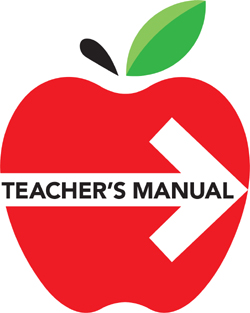
Christopher Bruhn
AP Physics Teacher, L.D. Bell High School, Hurst, Texas
Thanks to Greg Jacobs, an AP physics teacher at Woodberry Forest School in Virginia, for developing the 5-step approach used in this teaching guide.
Introduction to the Teacher’s Manual
Today, teachers have a veritable mountain of resources for the AP Physics 2 class. No longer limited to just the textbook, today’s teachers have access to online simulations, apps, computer-based homework, video lectures, and so on. The College Board itself provides so much material related to the AP Physics 2 exam that teachers, and students, can easily become overwhelmed by an excess of materials and resources.
This book is a vital resource for you and your class. It explains in a straightforward way exactly what a student needs to know to be successful on the AP Physics 2 exam. In addition, it provides a complete review for the test, including explanatory materials, questions to check student understanding, and three AP-style practice exams.
The 5 Steps of Teaching AP Physics 2
This Teacher’s Manual will take you through the 5 steps of successful AP Physics 2 instruction. These steps are:
![]() Prepare a strategic plan for the course
Prepare a strategic plan for the course
![]() Hold an interesting class every day
Hold an interesting class every day
![]() Evaluate your students’ progress
Evaluate your students’ progress
![]() Get students ready to take the AP exam
Get students ready to take the AP exam
![]() Become a better teacher every year
Become a better teacher every year
I’ll discuss each of these five steps, with suggestions and ideas of things that I do in my own class. I’m sharing activities that, over the years I have found have helped my students learn and achieve success on the AP exam. Let me be clear: I am still growing as a teacher, and every year my class changes. I always tell teachers that they each have their own style with unique strengths and weaknesses. You need to find your own “groove” that maximizes your students’ growth and achieves success. Discover what works for you and your students. The point is for you to learn, try new things, and strive for improvement. Teaching AP Physics 2 is truly a journey and not a formula.
I hope you enjoy this Teacher’s Manual and find ideas and strategies that will be useful to you.
STEP 1
Prepare a Strategic Plan for the Course
Know the Content of AP Physics 2 and Set Up a Sequence/Calendar
The Course and Exam Description (CED) from the College Board can be found at https://apcentral.collegeboard.org/pdf/ap-physics-2-course-and-exam-description.pdf?course=ap-physics-2-algebra-based—or you can simply search for “AP Physics 2 CED.” It lays out a scope and sequence for the AP Physics 2 class, though the course does not have to be taught in the unit order presented by the College Board. However, the College Board’s sequence is set up so that topics and skills build as the year goes on. When working with teachers at AP Summer Institutes and AP Workshops, I recommend that new AP Physics 2 teachers follow the suggested scope and sequence, or follow the sequence in a good college-level textbook.
After you have taught the course a few times and feel comfortable with the material, you may wish to move topics and units around to better meet your classroom needs. Some teachers like to start the year with electricity and magnetism because it is the largest portion of the content. I know others who begin with the wave unit. Personally, I feel the College Board sequence flows well. I like the idea of starting with fluids because it connects us to our previous study of AP Physics 1 through mechanics and is a natural jumping-off point for the course. Thermodynamics takes us into the realm of atoms and is a nice bridge between mechanics, where we can see and touch what we are studying, and electricity and magnetism, where charges and fields stem from particles we cannot see. Finally, I like the way the waves unit introduces us to interference and the nature of light, which flows nicely into these concepts in the quantum unit. The point is that there is more than one way to lead our students through a successful course.
The chart below shows the units and the time suggested by the College Board for each unit. The number of class periods is based on a typical 45-minute class, 5-period-a-day course. This pacing is similar to what I use in my own class, which is also shown in the table. If your school is on a block schedule or other schedule, you will need to adjust the pacing to fit your class needs.
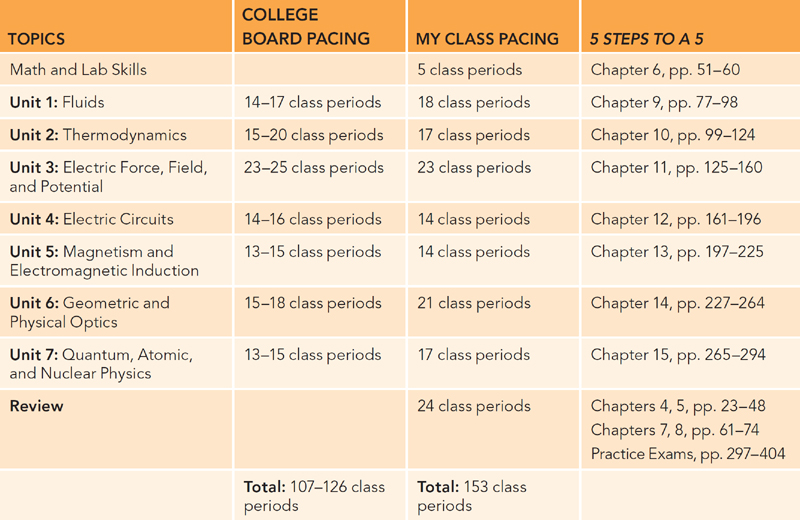
Notice that the number of class periods for my calendar is similar to the College Board’s. The main difference is that I added time at the beginning of the course to work on math and lab skills, as well as class procedures and expectations. I also built in 4 to 5 weeks of review.
It is imperative that you set up and stick to a schedule! You simply cannot end up at Thanksgiving having completed only a couple of units. Every year we have teachers that extend a unit well past when it should have ended because they don’t want to leave any students behind. While this is an admirable goal, by continuing units too long, teachers doom the entire class to failure because later content is either not covered or rushed through. You must move on. Most students will need several weeks of review to crystalize their understanding of the content before the AP exam. I find that during the review, many of my lagging students have their light-bulb moment when they finally connect the missing pieces that were sketchy early in the year.
Build Student Skills and Confidence to Achieve Success
I have led a lot of AP teacher training sessions. Invariably some of the participants will lament (complain) that their students come to class with little to no skills: “They come to class, and they don’t know anything.” I like to remind these teachers that if a student came to class with all the necessary skills to learn physics, then the student wouldn’t need us at all! Remember that our students are still just proto-adults. Children in full-sized bodies. They have a lot of growing up to do. Students need our help to put it all together. That is where we come in.
I’ve had meetings with many math teachers in different school districts, and they all assure me that the students that enter my AP Physics 2 class have been taught how to graph and how to rearrange a literal equation for a particular unknown. Our students have seen and used trig functions and practiced right-triangle geometry. They have used a calculator. The English teachers swear that my students have been shown how to form a sentence and write a persuasive argument. The chemistry and biology teachers promise that they have taught lab skills, how to graph, unit conversion, and what independent and dependent variables are.
Our students should have been exposed to what they need to succeed in AP Physics 2. So what gives? Why do students seem so lacking?
There is a huge difference between covering material and weaving it through the content. Students seldom become proficient with content that is covered once, tested, and rarely reinforced again. Our math department teaches literal equations in middle school. It is no surprise that students have trouble rearranging a symbolic equation when they get to physics. We need to help students resurrect this long-atrophied skill.
Furthermore, content learned in one context is not easily transferred to a new context by developing learners. The symbols are different in math than in physics. The words you use when talking about physics differ from the words used in chemistry and biology. Connections that you can make between subjects and contexts are not as easy for our immature learners.
What do we, as AP Physics teachers, need to take away from this?
1. I always tell teachers that they need to assume that students come into class with no reliably usable skills. Simply accept the fact that your students need your help with the skills necessary for success.
2. Your students have indeed been exposed to math, English, and science skills in previous classes. What they can’t easily do is recall the content and apply these skills to our physics class. Help your students connect this cloudy previous learning to physics.
3. Be positive about this process of skill building, because you’re helping your physics children become fully actualized adult learners. Besides, you don’t want those college professors complaining about you sending them students with no skills.
4. Remember: Rome ne s’est pas faite en un jour (Rome wasn’t built in a day). A student brain needs to marinate in physics thought for a long time before it is ready to perform like a pro. So start early and reinforce often! I begin building skills the first week of school and dedicate time in each unit to skill building.
I have found that my students need a lot of dedicated work on these skills:
![]() Math skills. Deriving equations, proportional reasoning, graphing, linearization
Math skills. Deriving equations, proportional reasoning, graphing, linearization
![]() Reasoning skills. Ranking tasks, comparison tasks, changing representations, conflicting contentions, troubleshooting tasks (TIPER-style questions)
Reasoning skills. Ranking tasks, comparison tasks, changing representations, conflicting contentions, troubleshooting tasks (TIPER-style questions)
![]() Constructing a written argument. Explaining, justifying, building paragraph arguments
Constructing a written argument. Explaining, justifying, building paragraph arguments
![]() Laboratory skills. Designing a laboratory procedure, effectively displaying the data, drawing information and conclusions from the lab data
Laboratory skills. Designing a laboratory procedure, effectively displaying the data, drawing information and conclusions from the lab data
Now let’s take a look at each of these in some detail.
Math Skills
The first few days of class we begin building our mathematical muscles. Here are some examples of what we do starting day 1:
![]() Unit conversions
Unit conversions
![]() Geometry/trigonometry (right triangles, sine, cosine, tangent)
Geometry/trigonometry (right triangles, sine, cosine, tangent)
![]() Algebra (solving a literal equation for a specific variable, fractions, proportional reasoning with symbolic equations)
Algebra (solving a literal equation for a specific variable, fractions, proportional reasoning with symbolic equations)
![]() Graphing skills with experimental data (using the proper plotting technique, finding the equation of the best-fit line, explaining the physical meaning of the slope and intercept, making predictions from the data)
Graphing skills with experimental data (using the proper plotting technique, finding the equation of the best-fit line, explaining the physical meaning of the slope and intercept, making predictions from the data)
![]() Linearization (identifying the mathematical model that represents a data set, identifying what a graph will look like from a symbolic equation, choosing what to put on each axis to linearize the data, determining what the slope represents)
Linearization (identifying the mathematical model that represents a data set, identifying what a graph will look like from a symbolic equation, choosing what to put on each axis to linearize the data, determining what the slope represents)
Plan to reinforce these basic skills over the entire class. Drop some of these types of questions in class as bell ringers or exit tickets. Remind students of these skills as they naturally come up in class. Remember, it takes many repetitions before a student can really own these topics. Continue developing these mathematical skills throughout the entire course. This is particularly true of deriving symbolic equations and graph linearization.
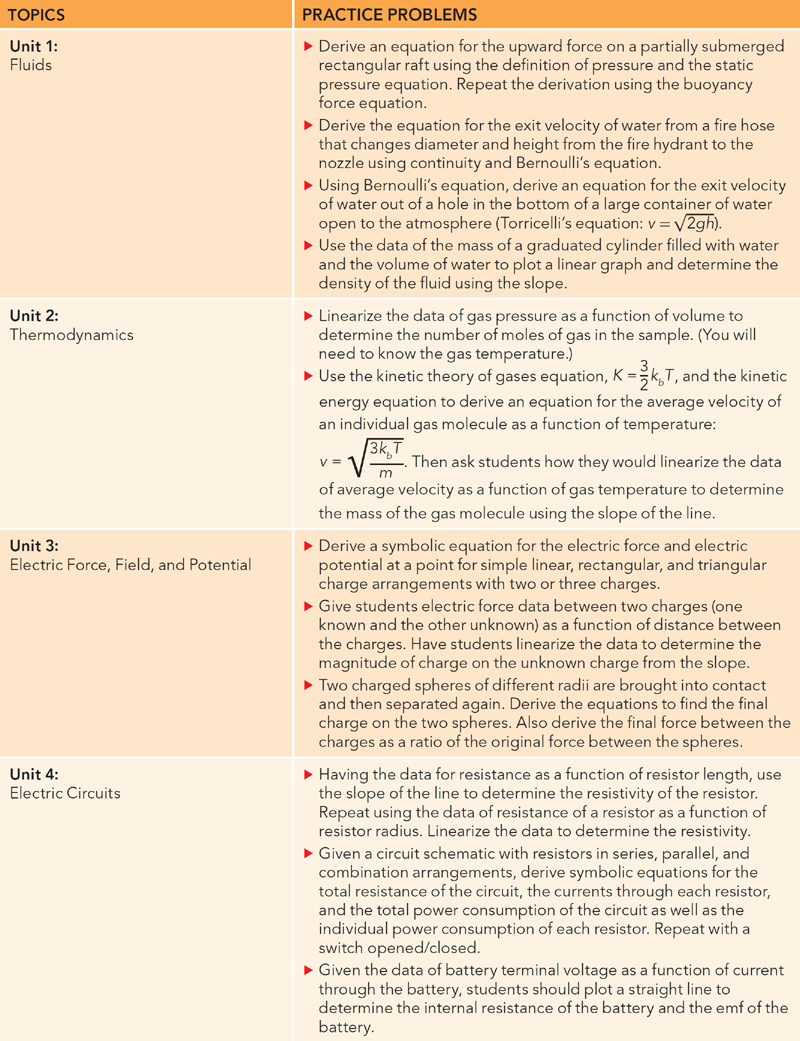
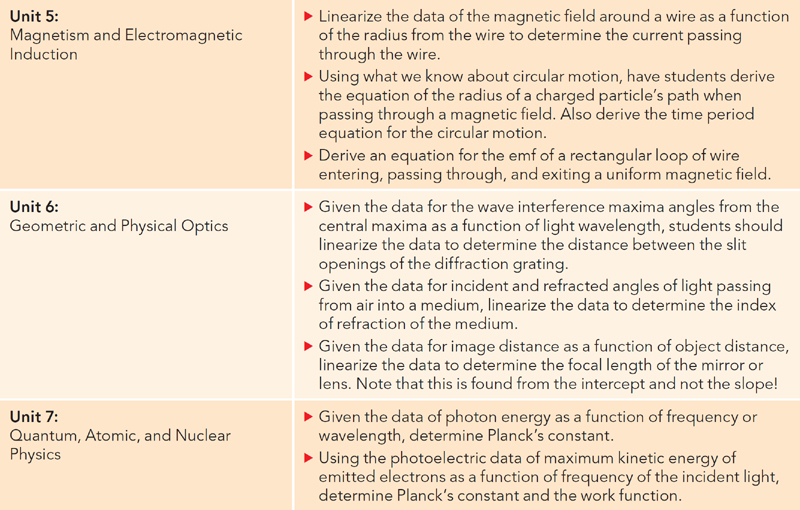
The important thing is to practice symbolic derivations and linearization skills throughout the entire course, because these skills will help your students gain confidence and skill over time. By the time the AP Physics 2 exam rolls around, your students will have greater success.
Reasoning Skills
Many teachers cover the course content and then assign a bunch of numerical and word problems for the students to solve. This is certainly one way to teach physics, but let’s be clear—this style of teaching will not help most of your students be successful on the AP exam. Reasoning skills differ from numerical problem-solving skills. Physics reasoning involves explaining, comparing, evaluating, and doing scientific augmentation. These skills are gained over time through practice.
So how do we transition to a classroom environment that builds reasoning skills? My suggestion is to replace two-thirds of the traditional numerical and word problems with TIPER-style questions. TIPER stands for tasks inspired by physics education research. A lot of study has gone into what types of tasks really help students grasp physics. These tasks/problems involve things like proportional reasoning questions, ranking tasks, comparison tasks, changing representations, conflicting contentions, troubleshooting tasks, constructing an argument, predict and explain, and what-if-anything-is-wrong questions. Most of these types of tasks cannot be easily solved with a mathematical routine. A key element of these types of tasks is that the correct answer is not nearly as important as the process of determining the answer and the students’ explanation of their thought process. These types of questions encourage class discussion and participation.
Where can you can find these types of questions?
![]() In this book, of course. 5 Steps to a 5: AP Physics 2
In this book, of course. 5 Steps to a 5: AP Physics 2
![]() In the companion book. 5 Steps to a 5: 500 AP Physics 2 Questions to Know by Test Day
In the companion book. 5 Steps to a 5: 500 AP Physics 2 Questions to Know by Test Day
![]() Newer college textbooks that advertise to be AP Physics editions
Newer college textbooks that advertise to be AP Physics editions
In addition:
![]() AP Classroom has a large test bank that moves from simpler topic questions all the way to released AP questions.
AP Classroom has a large test bank that moves from simpler topic questions all the way to released AP questions.
![]() TIPERs. Sensemaking Tasks for Introductory Physics has reasoning questions for every topic in AP Physics 1 and 2.
TIPERs. Sensemaking Tasks for Introductory Physics has reasoning questions for every topic in AP Physics 1 and 2.
I sprinkle these types of reasoning questions throughout the entire course. These types of questions can generate class discussion in both small groups and the entire class. In this way I can multiply the amount of educational physics activity occurring in class. These types of questions build students up so that they can handle actual AP-style questions.
Constructing a Written Argument
OK, now that we have students discussing physics by using our reasoning tasks, the next step is to have students put these thoughts down in writing. The AP Physics 2 exam asks students to explain, justify, and construct paragraph-length arguments in writing. I’ll be honest. This is a difficult transition for most students. Talking is one thing, but putting ideas down on paper makes it “real.” Here is how I move students through the transition.
First, we discuss how to form a good argument. We do this in the first unit of the course. Most of you are aware of the CER (claim-evidence-reasoning) approach. (You can do a web search for CER for more information.) This is an excellent technique to use in developing a scientific argument. I have also used the ABCD method that I learned from an AP Physics colleague John Frensley:
A. Be sure to answer the question that is asked.
B. What basic physics are you using in your argument? This is something that is always true. For example, the slope of the velocity-time graph is the acceleration. Another example would be, momentum is conserved for the system when there are no net external forces.
C. What is the critical information specific to this problem? These are things that are specific to the problem in question—things like object A has twice the charge of object B, but is only going half the velocity of object B as the two objects pass through the magnetic field. This is where a student indicates the critical points of the problem that make a difference in the solution to the question.
D. Draw your argument together! This is the final step where students put forth their argument in writing.
To help students organize their thoughts, I have them draw a T-chart as seen below:
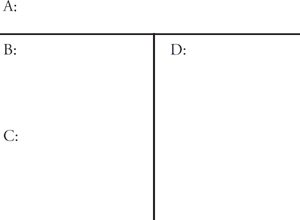
The first thing students do is decide what basic physics (B) is applicable to this problem and write it on the left. This can include physics equations and any math. Next, they call out the important critical information (C) in the problem on the left. I tell students that the left side of the paper is their brainstorm area. Next, on the right, students flesh out their written argument (D). In their argument, they can use equations, symbols, and diagrams as long as they are all strung together with a backbone of words. It is a written argument after all! Finally, at the end, they write their answer (A) to the question at the top. Why wait until the end for the answer? Because most of the time you don’t know the answer until you have brainstormed and reasoned your way to the solution. Plus, anyone reading the student’s response will instantly know where the student’s argument is headed. I find the ABCD method particularly useful for the paragraph argument free-response question, as it gives students a structure that takes some of the fear out of the problem.
Once we have discussed what a good argument needs to look like (CER or ABCD), we start practicing. I start students off with some TIPER questions for which I have previously turned the answer key into points. Usually, the question is between 3 and 5 points. I award 1 point for the correct answer and additional points for each critical idea that leads to the correct answer. (The idea is that most of the points come from the explanation and not the answer itself.) Students are placed in small groups that work together to form a consensus on the answer. Then I have them write one single answer for the group. Finally, we grade the group’s response. As the year goes on, the students working in groups begin writing individual responses. We progress to students working alone, writing but comparing their answer with each other before scoring. The last step in this progression is to have students work completely alone.
This is a hard skill for students to learn, so dedicate time to writing. This process takes months, but it is worth it. My students’ free-response scores have improved due to the effort. I get most of my writing prompts from questions in 5 Steps to a 5: 500 AP Physics 2 Questions to Know by Test Day. You can also use TIPER questions or free-response questions found in the AP Classroom Question Bank.
Laboratory Skills
One of the free-response questions will always be a lab-based question. This requires students to design a laboratory procedure, effectively display the data, draw information from the data, and then make conclusions based on the data. In addition, several of the multiple-choice questions involve laboratory skills. It is important for you to move away from follow-directions—cookbook-style labs and move toward guided inquiry labs in your classroom. Most of the labs my classes do are guided inquiry.
In its simplest terms, guided inquiry is where the teacher sets up the parameters of the lab but leaves the details up to the students. For example, give the students a set of insulated metal spheres and ask them to determine if the spheres are charged and what is the sign of the charge. You can also ask them to rank the charges on the spheres from most positive to most negative. Notice that the students are not told what to do, what equipment to use, or what measurements to take. These details are left up to the students. That’s it!
At first students will need a lot of support and structure during guided inquiry labs, because most students have never been asked to do this in other science classes. Electronic or by hand, here is what I would want in every lab report:
1. Title and purpose of the lab (I give them both of these).
2. List of lab equipment and what is being measured by each device.
3. Sketch of the lab setup. The equipment should be labeled, and measurements should be labeled with an appropriate symbol.
4. Lab procedure written as a numbered list. I want a numbered list because it forces students to think about the order in which things need to be done.
5. Equations used for any calculations. Students don’t need to show all calculations, but they must show the symbolic equations they are using.
6. Data, presented in table and/or graphical form as appropriate to the lab. This can be in written form if there is no numerical data.
7. Results and conclusions.
This structure helps students know what is expected and also trains them to perform on the AP exam. Take pictures of good lab reports and show students so they know what is expected of them. I also suggest returning any messy, illegible, or otherwise poor lab reports for students to rewrite/redo. Students will hate you for it, but I always tell them something like this: “Look, I care about you and your grade in class. I want you to be successful on the AP exam. What you have turned in currently is a zero in the gradebook and will not help you on exam day. I’m giving you the opportunity to improve. Writing labs is a growth process, and you have room to grow.” I’ve rarely had a student have to rewrite more than a lab or two.
The process of learning how to design a lab takes time. After giving the students the lab title and purpose, you need to guide them through the lab design. Here are some suggestions:
![]() Early in the year, you may want to introduce the lab the day before and have students come up with ideas about how to perform the lab as an assignment. The next day, students can report out to the entire class their plan for the lab. Speaking to the students together as a class, you can guide them through the process of picking two or three different procedures that not only would work, but are feasible and easy to accomplish. This is important because students tend to pick some really difficult ways to complete the lab and need to be taught that simpler is better.
Early in the year, you may want to introduce the lab the day before and have students come up with ideas about how to perform the lab as an assignment. The next day, students can report out to the entire class their plan for the lab. Speaking to the students together as a class, you can guide them through the process of picking two or three different procedures that not only would work, but are feasible and easy to accomplish. This is important because students tend to pick some really difficult ways to complete the lab and need to be taught that simpler is better.
![]() As their skill improves, let the students take more and more ownership of the process. Put the students in groups, present the lab, and let them brainstorm ideas. Finally, have them report to the entire class their plans. All the while, you are offering support and suggestions. This gives all the students a chance to evaluate and revise their plans.
As their skill improves, let the students take more and more ownership of the process. Put the students in groups, present the lab, and let them brainstorm ideas. Finally, have them report to the entire class their plans. All the while, you are offering support and suggestions. This gives all the students a chance to evaluate and revise their plans.
![]() Once the students have developed some skills, present the lab to the students and have each group come up with its own plan. Actively monitor the groups, but only intervene when students get off track or need assistance. Try not to give them the answer, but ask them leading questions. I like to take groups that are really lost and tell them to “spy” on other groups to get ideas. Or have a group that is way ahead of others go around and help the other groups in need.
Once the students have developed some skills, present the lab to the students and have each group come up with its own plan. Actively monitor the groups, but only intervene when students get off track or need assistance. Try not to give them the answer, but ask them leading questions. I like to take groups that are really lost and tell them to “spy” on other groups to get ideas. Or have a group that is way ahead of others go around and help the other groups in need.
![]() It is important to have the students develop their plan before they begin the lab. I learned this the hard way. Make students complete Steps 1—4 of the lab write-up before they touch the equipment. This cuts down on false starts and lots of wasted time.
It is important to have the students develop their plan before they begin the lab. I learned this the hard way. Make students complete Steps 1—4 of the lab write-up before they touch the equipment. This cuts down on false starts and lots of wasted time.
The following are guided inquiry labs that can be used in AP Physics 2.
Guided Inquiry Labs That Can Be Used in AP Physics 2
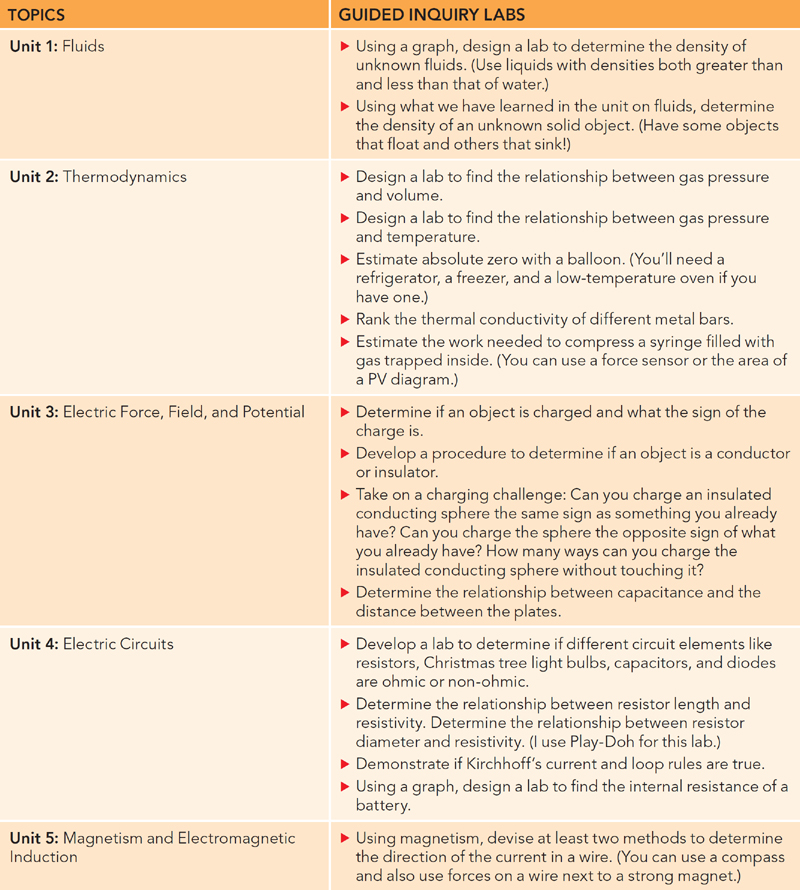
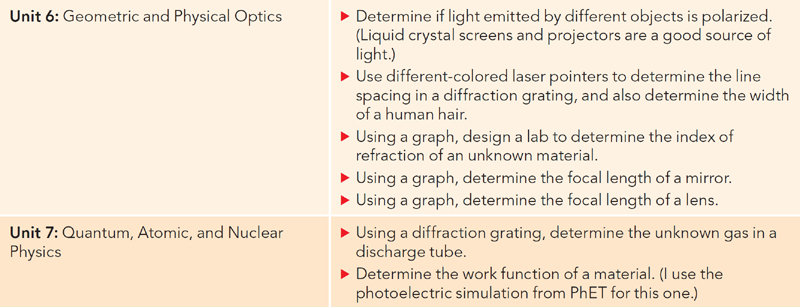
Some of these labs will require equipment that you may not have. You don’t have to perform all these labs every year. I don’t. Just start moving your classroom to a more guided inquiry approach. Your students will learn more and perform better on the AP exam.
STEP 2
Hold an Interesting Class Every Day
The AP Physics 2 exam requires deep conceptual understanding, as well as the ability to move between multiple representations of a situation, skillfully argue a point using sound scientific reasoning, and design a laboratory experiment to answer a specific question. Notice that I did not mention “solve problems.” Every year I ask my students how many times they used their calculators on the AP exam. The answer is almost always less than five times. The same is true of the equation and constant sheet. If your AP class consists of mostly lecture, numerical problem solving, and cookbook-style labs . . . well you’re not giving your students much of a chance.
Successful AP Physics 2 classrooms have several things in common:
1. Attitude. It all starts with the teacher’s attitude. You need to like teaching physics, because excitement spills over to the students. It’s actually more important that you enjoy sharing physics with the students than knowing everything there is to know about the subject matter. It’s a joy to help students to their light-bulb moment when a physics truth crystalizes for them. The look on the students’ faces is priceless. I hope you appreciate it, because no other class makes students feel smarter than physics.
2. Positivity. On the flip side, no other class make students feel dumber than physics. In physics, we are attempting to get students to unlearn the incorrect things they think they know about how the world works, and learn things that aren’t always intuitively obvious. The subjects can be difficult to grasp, and if we are not careful, that can be demoralizing to our students. You need to keep a positive and encouraging environment in your classroom. (Personally, I joke around with my students, and we laugh a lot in class. I use this to keep the room positive and fun.)
3. Growth mindset. Most students won’t understand physics the first time through. Or the second time, or the third time. But they will get it! I tell my students that they will understand physics. None of them were born with a PhD in physics. Some will take more time than others, but they will all progress and learn. I truly believe it. One of my students came back to visit after graduating. He said to me: “Mr. Bruhn, you’ll never going to believe it! I’m taking physics in college, and everyone comes to me for answers and advice. I’m the physics rock star now.” This was a student who had rightfully earned a 1 on the AP Physics exam. So keep fertilizing those budding physics brains.
4. Collaborative environment. Science is a team sport. People work together to learn and discover. It should be the same in your classroom. I tell my students: “I expect you to cheat . . . I mean . . . collaborate with your neighbors in class. When you’re lost, consult your group. When you don’t know the answer, ask your partner. When you get an answer, check your results with the person sitting next to you. This is how science works. We cheat . . . I mean . . . collaborate all the time. This is how we learn and gain confidence in our knowledge.” You can’t possibly meet all the needs of your students in a timely fashion. Multiply your efforts by utilizing the power of numbers in your class. Empower your students to take ownership of the class and help others in class.
5. An environment conducive to pushing those birds out of the nest and letting them fly. As the year goes on, there should be less of you leading the class and more of the students taking control of their learning. Don’t get me wrong; you’re still in charge. But your involvement should focus on presenting new material and orchestrating the learning environment; your students should come to you less and less for answers and begin to figure things out on their own. Early in the year establish the practice that students should not come to you first with questions. They should seek help from their group. They should reread their notes or pick up their textbook. Remember that the learning does not come from being told the correct answer, but in the struggle to find the answer. This is an important step in their growth and future success.
STEP 3
Evaluate Your Students’ Progress
As you know, there are two types of assessments: formative and summative. Formative assessments are intended to evaluate where the students are, what they understand, and where their conceptual gaps are. Formative assessments are intended to inform what we as teachers do next with our students. Summative assignments are what gets put in the gradebook. I’m going to concentrate on formative evaluations because they are the most powerful for teachers.
At the bottom of the formative assessment ladder are informal questions asked by you directly to your students. I encourage you to ask many questions when you lead your class. For example:
![]() Thermodynamics (Unit 2). Which has more energy, a glass of boiling water or a bathtub full of warm water? Why does the boiling water burn you, but the bathwater feels nice? Can you sketch the speed distribution of water molecules in both the boiling water and the bathtub?
Thermodynamics (Unit 2). Which has more energy, a glass of boiling water or a bathtub full of warm water? Why does the boiling water burn you, but the bathwater feels nice? Can you sketch the speed distribution of water molecules in both the boiling water and the bathtub?
![]() Electric Force, Field, and Potential (Unit 3). This Styrofoam packing peanut sticks to me. Does that mean it has a charge? How can I tell if it has a charge, and what is the sign of the charge? Would it take work to remove the packing peanut from me? Can you sketch the electric field vector diagram of the peanut and me?
Electric Force, Field, and Potential (Unit 3). This Styrofoam packing peanut sticks to me. Does that mean it has a charge? How can I tell if it has a charge, and what is the sign of the charge? Would it take work to remove the packing peanut from me? Can you sketch the electric field vector diagram of the peanut and me?
![]() Electric Circuits (Unit 4). If we open the switch in this circuit, how will the currents in each light bulb be affected? Will their brightness change? Rank the brightness of the bulbs before and after the switch is opened.
Electric Circuits (Unit 4). If we open the switch in this circuit, how will the currents in each light bulb be affected? Will their brightness change? Rank the brightness of the bulbs before and after the switch is opened.
Questions like these challenge students to process what they have learned and help you know what to do next in class.
The next step up the formative assessment ladder comprises questions that are more structured and formal. I use questions from the 5 Steps to a 5: AP Physics 2 and 500 Questions to Know by Test Day books as well as questions from AP Central and released AP questions. Most of these I do not take for a grade, but use as instructional pieces in class.
Finally, at the top of the formative assessment ladder, I would like you to consider students’ homework, laboratory experiments, and even exams as formative in nature. You really shouldn’t assign something to students “just for a grade.” Whatever the assignment, it should give you data that helps inform your instruction and elevate student outcomes. Which tests and tasks did they struggle with? This will help you when it’s time to review.
STEP 4
Get Students Ready to Take the AP Exam
OK! You have stuck to your schedule and have 4 to 5 weeks before the exam. It’s time to review. Here is what I suggest:
1. Give a full AP mock exam. I do this immediately after completing all the course content. I want students to know where they are and what an AP Physics 2 exam feels like. This serves to get their attention and focus them on what needs to be improved before exam day. Based on the data you have collected from homework, summative exams, and the mock exam, you should have a good idea of what your students need to work on.
2. Spend time reviewing the content areas where students had the most difficulty on the mock exam. Don’t just repeat the same instruction from earlier in the year. Do something different. For example, I grade the mock exam but don’t show them what they got right or wrong. I just show them their overall grade on a 5-point AP scale. Next, students in small groups work together to create what they think is the key to the exam. The groups then share their answers with each other and work toward a whole class consensus for what all the correct answers are. Every year the students create a mostly accurate key and earn a grade of 5 as a class. Then I help them through the questions that are still giving them trouble.
3. Assign review problem sets for each AP Physics 2 unit. You can also build cross-unit problem sets that concentrate on specific skills: lab-based FR, pick-two MC, and so on. Focus on areas where students are weak. I assign these problem sets at the start of each week and collect them on Friday. I encourage students to work together in groups through the assignments because this is about gaining mastery and not assigning a grade. I give time in class for this process. Questions are pulled from the 5 Steps to a 5: AP Physics 2 and 500 Questions to Know by Test Day books as well as questions from AP Central and released AP questions.
4. Do some additional guided inquiry laboratory experiments where students design the lab. Use the 5 Steps to a 5: AP Physics 2 and 500 Questions to Know by Test Day books and released AP questions as the starting points on these labs.
5. Work goal-less problems. A goal-less problem is simply a description of a physics situation without any questions. The student’s task is to deduce as much information as possible about the situations. Here is an example I pulled from 5 Steps to a 5: 500 Questions to Know by Test Day:
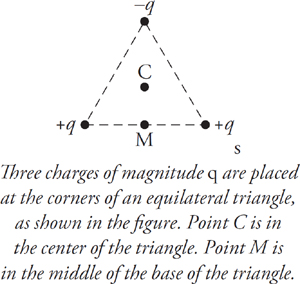
Notice that this is not a question but only a description. What could students determine from this situation? Quite a few things actually! Here are some possibilities:
![]() Draw the force vectors on each charge.
Draw the force vectors on each charge.
![]() Sketch the electric field vector diagram.
Sketch the electric field vector diagram.
![]() Calculate the electric field at points C and M.
Calculate the electric field at points C and M.
![]() Sketch the electric potential isolines.
Sketch the electric potential isolines.
![]() Calculate the electric potential at points C and M.
Calculate the electric potential at points C and M.
What can be determined is limited only by students’ creativity and their physics skill! I put my students in groups with whiteboards and run this as a friendly game show competition to see what groups can come up with the most discoveries. Year after year students tell me this is their favorite way to review for the AP exam.
STEP 5
Become a Better Teacher Every Year
It is my belief that in education either you are moving forward, or you are moving backward. I encourage you to find ways to grow. Here are some suggestions:
![]() Set SMART goals for yourself. SMART stands for specific, measurable, attainable, relevant, and time-bound. When I moved to my current school, one of my SMART goals was to double the enrollment in the AP Physics program by the next school year while maintaining the same percentage of qualifying scores on the exam.
Set SMART goals for yourself. SMART stands for specific, measurable, attainable, relevant, and time-bound. When I moved to my current school, one of my SMART goals was to double the enrollment in the AP Physics program by the next school year while maintaining the same percentage of qualifying scores on the exam.
![]() Attend an AP Summer Institute for AP Physics 2. If you have already attended one, wait a few years and then attend another with the perspective of a more seasoned instructor. Or attend one with a different presenter.
Attend an AP Summer Institute for AP Physics 2. If you have already attended one, wait a few years and then attend another with the perspective of a more seasoned instructor. Or attend one with a different presenter.
![]() Every year, review your instructional planning report (IPR) provided by the College Board to see where your students’ strengths and weaknesses are on the AP exam. The IPR is where I found that my students needed a lot of work on written arguments and explanations.
Every year, review your instructional planning report (IPR) provided by the College Board to see where your students’ strengths and weaknesses are on the AP exam. The IPR is where I found that my students needed a lot of work on written arguments and explanations.
![]() Every year, take notes about what worked in class and what didn’t. Then choose something to improve.
Every year, take notes about what worked in class and what didn’t. Then choose something to improve.
![]() Try something new each year—introduce a new lab; use a different teaching technique; rewrite those old exams; find a new demonstration. Over time you will have a varied and powerful teaching arsenal.
Try something new each year—introduce a new lab; use a different teaching technique; rewrite those old exams; find a new demonstration. Over time you will have a varied and powerful teaching arsenal.
![]() Join a physics community. Here are two national AP Physics communities that have helped many teachers over the years:
Join a physics community. Here are two national AP Physics communities that have helped many teachers over the years:
![]() National AP Physics Teachers Facebook community (https://www.facebook.com/groups/485324748333586)
National AP Physics Teachers Facebook community (https://www.facebook.com/groups/485324748333586)
![]() PrettyGoodPhysics community (https://sites.google.com/prettygoodphysics.org/prettygoodphysics/home?authuser=0/)
PrettyGoodPhysics community (https://sites.google.com/prettygoodphysics.org/prettygoodphysics/home?authuser=0/)
![]() Become an AP Physics reader. Teachers who attend the reading almost unanimously say it changes the way they teach their subject. You learn the inner workings of the AP exam, you meet great people like yourself, and you get paid! What could be better!? Here is a link to the College Board for more info: https://apcentral.collegeboard.org/professional-learning/become-an-ap-reader.
Become an AP Physics reader. Teachers who attend the reading almost unanimously say it changes the way they teach their subject. You learn the inner workings of the AP exam, you meet great people like yourself, and you get paid! What could be better!? Here is a link to the College Board for more info: https://apcentral.collegeboard.org/professional-learning/become-an-ap-reader.
![]() Attend a physics or science teachers convention.
Attend a physics or science teachers convention.
![]() Read a physics-related book or watch some physics videos from Veritasium, SciShow, Smarter Every Day, Kurzgesagt, or minutephysics.
Read a physics-related book or watch some physics videos from Veritasium, SciShow, Smarter Every Day, Kurzgesagt, or minutephysics.
It is fun to learn and grow. Not only do you broaden your horizons, but you get inspired with cool ideas to use in class! Your students will love you all the more for it.
Additional Resources for Teachers
BOOKS
![]() 5 Steps to a 5: 500 Questions to Know by Test Day
5 Steps to a 5: 500 Questions to Know by Test Day
![]() TIPERs: Sensemaking Tasks for Introductory Physics
TIPERs: Sensemaking Tasks for Introductory Physics
WEBSITES
![]() AP Central and AP Classroom (https://apcentral.collegeboard.org/)
AP Central and AP Classroom (https://apcentral.collegeboard.org/)
![]() PhET Interactive Simulations (https://phet.colorado.edu/)
PhET Interactive Simulations (https://phet.colorado.edu/)
![]() oPhysics: Interactive Physics Simulations (https://ophysics.com/)
oPhysics: Interactive Physics Simulations (https://ophysics.com/)
![]() Physics Classroom Interactives (https://www.physicsclassroom.com/Physics-Interactives)
Physics Classroom Interactives (https://www.physicsclassroom.com/Physics-Interactives)
![]() Goal-less problems, Physics! Blog! (https://kellyoshea.blog/2011/03/05/goal-less-problems/)
Goal-less problems, Physics! Blog! (https://kellyoshea.blog/2011/03/05/goal-less-problems/)
![]() Veritasium (https://www.youtube.com/channel/UCHnyfMqiRRG1u-2MsSQLbXA)
Veritasium (https://www.youtube.com/channel/UCHnyfMqiRRG1u-2MsSQLbXA)
![]() SciShow (https://www.youtube.com/scishow)
SciShow (https://www.youtube.com/scishow)
![]() Smarter Every Day (https://www.youtube.com/channel/UC6107grRI4m0o2-emgoDnAA)
Smarter Every Day (https://www.youtube.com/channel/UC6107grRI4m0o2-emgoDnAA)
![]() Kurzgesagt (https://www.youtube.com/channel/UCsXVk37bltHxD1rDPwtNM8Q)
Kurzgesagt (https://www.youtube.com/channel/UCsXVk37bltHxD1rDPwtNM8Q)
![]() Minutephysics (https://www.youtube.com/user/minutephysics)
Minutephysics (https://www.youtube.com/user/minutephysics)